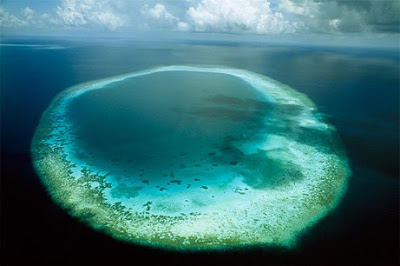Saturday, July 25, 2009
Wonders of the world
One of the 28 New7Wonders of Nature finalists, the Maldives are made up of 1,192 small islands (including the above), but people live on only about 200 of them.
Even fewer of those islands will be inhabited if climate change continues to raise sea levels in the Indian Ocean, particularly around the low-lying capital of Maale (Male), experts say. (See pictures of Maale (Male) and other places endangered by climate change.)
If the Maldives make it to the final seven-wonders list, the resulting attention may inspire more action on climate change, Tourtellot suggested.
The world's tallest waterfall was named one of 28 finalists in an international contest to decide the seven wonders of the natural world via popular vote. At 3,287 feet (1,002 meters) tall, Angel Falls is more than 19 times taller than North America's Niagara Falls.
The falls are also situated in a region full of tepuis—tabletop mountains unique to northern South America—which are "in danger from inappropriate or thoughtless resource development, like power lines cutting through scenic areas," National Geographic sustainable-tourism expert Jonathan Tourtellot said.
"Tepui country could do for more tourism as an economic counterforce for that kind of thoughtless development," added Tourtellot, who is also spearheading the second-annual Geotourism Challenge, where voters chose places "they consider most cutting edge in providing visitors with authentic travel experiences, whether in a big city or a remote spot."
Researchers collect fish in Brazil's Anavilhanas Reserve in the Amazon Basin, which contains more than half of the planet's remaining rain forests.
On July 21, 2009, the species-rich region was named one of 28 finalists for the New7Wonders of Nature, a global contest that allows people to vote for the seven wonders of the natural world by Internet and phone, American Idol style.
(See all 28 of the finalists on the New7Wonders Web site.)
An expert panel helped the New7Wonders Foundation--the brainchild of Swiss filmmaker and museum curator Bernard Weber--choose the finalists based on unique beauty, ecological significance, and historical legacy, among other criteria.
"This is an extraordinary achievement and the eyes of the planet will be upon these 28 stunning locations for the next two years," Weber said in a statement.
Chosen by what the foundation hopes will be a billion voters, the winning seven wonders are to be announced in 2011.
In July 2007 the foundation announced the New Seven Wonders of the World, backed by more than a hundred million votes.
Jonathan Tourtellot, director of the National Geographic Society's Center for Sustainable Destinations, warns that the new natural wonders may be inundated with harmful tourism if their countries do not have a robust stewardship ethic. (The National Geographic Society owns National Geographic News.)
"When you draw attention to a place, you are automatically raising the tourism ante on that place. So if the place is not prepared for the increasing tourism that something like this might create, then there could be problems," he said.
But the Amazon, which spans 2,702,715 square miles (7 million square kilometers) in nine countries, is "not suffering from excess tourism, it's suffering from not enough tourism as a counterpoint for other uses in the Amazon Basin," such as lumbering or large-scale farming, Tourtellot explained.
Subscribe to:
Post Comments (Atom)



No comments:
Post a Comment